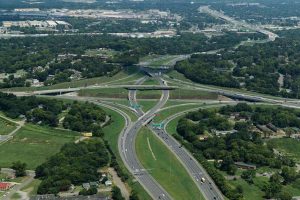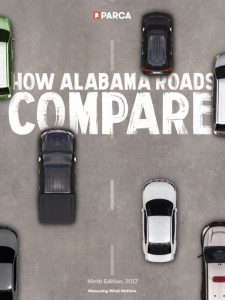|
PARCA’s latest report, How Alabama Roads Compare, provides an in-depth analysis of the conditions, funding and future of our state’s roads and bridges. Data presented in the report can also be viewed through interactive tables here. Alabama Roads: Where are we now? Alabama’s roads and bridges are in relatively good condition compared to other Southeastern states. The percentage of roads in good condition is higher than most other states and the percentage of roads in poor condition is lower than most other states. The percentage of bridges in need of replacement because of deficiency is about average for the Southeast. However, those generally good conditions on existing roads have come at a cost. The Alabama Department of Transportation has had to devote an increasingly large share of its budget to preserving the existing road system, with a shrinking pool of money available for new projects to address congestion or expand the road system to foster transportation improvements and economic development.
Currently, only $150 million per year is available for system enhancement and expansion projects, a drop in the bucket considering the billions of dollars in projects needed to address existing congestion issues, much less the additional billions that would be needed to finance aspirational projects like Birmingham’s Northern Beltline, a new Mobile River bridge, and variety of other projects desired by communities large and small. Alabama’s road spending in recent years has been supplemented by more than $1.3 billion in borrowing. That has allowed state and local governments to tackle needed improvements and perform in the present projects that will pay dividends in the future. However, that borrowing authority has been exhausted, and future road spending will be curtailed. The infusion of borrowed money is ending and the demands of paying back what has already been borrowed money will consume a greater share of road money. This impending road revenue crunch is rooted in a fundamental problem in how we pay for roads: a set 18-cents per gallon motor fuels tax. Per-gallon motor fuels taxes were last raised in the early 1990s. The buying power of that 18 cents on each gallon has eroded due to inflation. On top of that, the greater fuel economy of cars and trucks on the road today means that less gas in being purchased to fuel more miles of travel. The wear and tear of traffic on the roads continues to increase, but revenue from per-gallon taxes is not keeping pace. Per vehicle mile traveled, Alabama is collecting half what it did in the early 1990s, when adjusted for inflation. In the immediate term, the 2018 transportation budget will contain about $200 million less in revenue than it has enjoyed for the past 5 years, revenue provided through the ATRIP borrowing program. The debt service required to pay that borrowing back has been steadily climbing. In 2018, it will leap to $114 million, almost $50 million more than the 2017 total, and remain locked in for the next 19 years. As a bottom line, in 2018, there will be about $250 million less to spend on roads than there was in 2017. Where do we want to be in the future? Alabama needs sufficient revenue to pay for the upkeep of its current system, plus an adequate pool of money available to add capacity to address congestion problems and to improve the transportation network. That revenue for roads also needs to cover the cost of paying back the money the state has already borrowed. How do we get there? Alabama hasn’t raised its per gallon gas tax in 25 years. Only 8 other states have gone as long without an increase. In recent years, most states have raised per gallon taxes and have also adopted mechanisms to address the drain on buying power created by inflation and greater fuel economy. In the past several legislative sessions, Alabama lawmakers have introduced various proposals to address the impending shortfall in road funding but none of those proposals have gathered sufficient support. As those proposals resurface in subsequent sessions, attention should be paid not only to preventing the immediate shortfall but to preventing the perpetual erosion of road dollars. Many of our Southeastern neighbors have crafted long-term approaches to road funding from which Alabama could learn. Click here to read the full report, including information on traffic vs. capacity, construction and maintenance, road debt and more.
|


